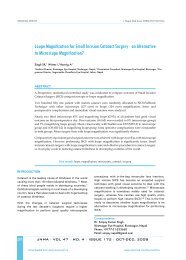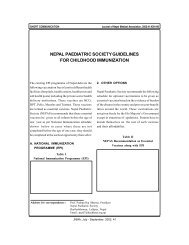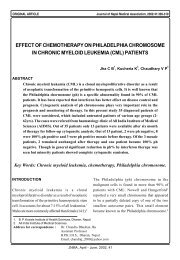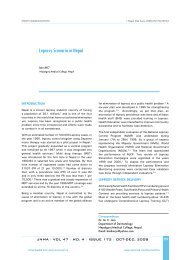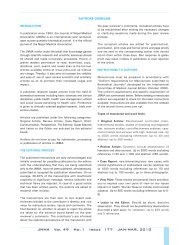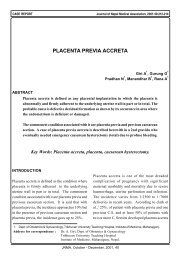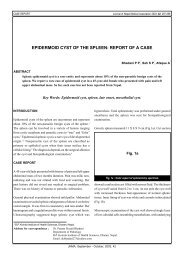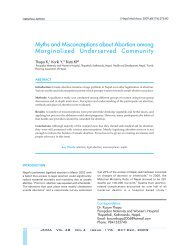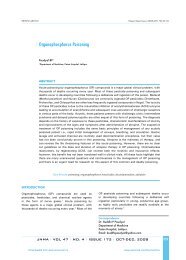Cardiovascular Collapse during Induction of General Anesthesia
Cardiovascular Collapse during Induction of General Anesthesia
Cardiovascular Collapse during Induction of General Anesthesia
Create successful ePaper yourself
Turn your PDF publications into a flip-book with our unique Google optimized e-Paper software.
CASE REPORT<br />
J Nepal Med Assoc 2007;46(167):130-132<br />
<strong>Cardiovascular</strong> <strong>Collapse</strong> <strong>during</strong> <strong>Induction</strong> <strong>of</strong><br />
<strong>General</strong> <strong>Anesthesia</strong><br />
Pradhan B 1<br />
1 Insatitute <strong>of</strong> Medicine, Maharajgunj, Kathmandu, Nepal.<br />
ABSTRACT<br />
Anaphylactic reactions to anesthetic drugs, though rare, may be encountered by anyone involved.<br />
The clinical manifestation <strong>of</strong> the anaphylactic reactions, which may be different from patient to<br />
patient, is caused by the histamine released either from the mast cells or basophils or both.<br />
Laboratory investigations can determine the source <strong>of</strong> histamine release. Here, I present a case<br />
<strong>of</strong> anaphylactic reaction to sodium thiopental. The main stay <strong>of</strong> the treatment is oxygenation,<br />
fluids and epinephrine, which was applied in this case also, with successful outcome <strong>of</strong> the<br />
patient.<br />
Key words: Adrenaline, Anaphylaxis, Anaphylactoid, <strong>Collapse</strong>, Thiopentole.<br />
INTRODUCTION<br />
Anaphylactoid reactions are more common than the true<br />
anaphylactic reactions with drugs related to anesthesia.<br />
<strong>Cardiovascular</strong> collapse presented with hypotension and<br />
tachycardia are the most common presentation <strong>of</strong><br />
anaphylactoid reactions. Here I present one case <strong>of</strong><br />
cardiovascular collapse following anesthetic drug<br />
administration.<br />
CASE REPORT<br />
A 22 years old male, weighing 60 kg with the diagnosis<br />
<strong>of</strong> left chronic suppurative otitis media tubo tympany<br />
was planned for elective left modified radical<br />
mastoidectomy. In preanesthetic check up the patient<br />
did not give any history <strong>of</strong> previous exposure to anesthetia,<br />
drug allergy or any other systemic pathology.<br />
Investigations were within normal limits. Heart rate was<br />
72 per minute regular, blood pressure 110/80 mm <strong>of</strong><br />
Hg in general physical examination. Systemic examinations<br />
were also normal. Airway evaluation revealed the patient<br />
<strong>of</strong> Mallampati Class II with free temporomandibular and<br />
atlanto occipital joints range <strong>of</strong> motion. The patient was<br />
categorized as <strong>of</strong> ASA I class. <strong>General</strong> anesthesia was<br />
planned for the patient. The patient was premedicated<br />
with Diazepam 10 mg orally night before surgery and in<br />
the morning <strong>of</strong> surgery.<br />
In the operation theatre on the day <strong>of</strong> surgery, monitors<br />
attached were pulse oximetry, electrocardiogram (ECG)<br />
and blood pressure. Intravenous (IV) line was opened in<br />
left hand with 18 G cannula. Preoperative blood pressure<br />
was 110/80 mm <strong>of</strong> Hg, pulse 80/min regular. Oxygen<br />
saturation was 99% in room air. Pethidine 40 mg was<br />
given and after 5 minutes anesthesia was induced with<br />
Sodium thiopentone 5 mg/kg. Immediate fall in oxygen<br />
saturation was noticed upto 90% which further decreased<br />
to 80% despite 100% oxygenation and manual ventilation,<br />
Correspondence:<br />
Dr. Bishwas Pradhan<br />
Department <strong>of</strong> Anesthesiology<br />
IOM, Maharajgunj, Kathmandu, Nepal.<br />
E mail: biswaspradhan@yahoo.com<br />
JNMA l Vol 46 l No. 3 l Issue 167 l JUL-SEP, 2007 130<br />
Downloaded from www.jnma.com.np, JNM Discussion Forum jnma.xenomed.com
Pradhan. <strong>Cardiovascular</strong> <strong>Collapse</strong> <strong>during</strong> <strong>Induction</strong> <strong>of</strong> <strong>General</strong> <strong>Anesthesia</strong> – A Case Report.<br />
that was started after apnoea. <strong>General</strong>ised sweating all<br />
over the body was noticed with predominance over the<br />
facial region. The patient also developed cutaneous<br />
flushing especially over the chest and face. Heart rate<br />
increased up to 140/minute with ECG showing normal<br />
configuration <strong>of</strong> complexes. Blood pressure with<br />
sphygmomanometer was recorded to be 40 mm <strong>of</strong> Hg<br />
with very feeble pulse. In the mean time patient was<br />
intubated with cuffed endotracheal tube <strong>of</strong> internal<br />
diameter 8.0 mm facilitated with Succinylcholine 100<br />
mg. Normal saline was infused rapidly from another IV<br />
access, obtained with 16 Gz canula in contralateral hand.<br />
Chest auscultation was normal with normal vesicular<br />
breath sounds bilaterally. After two liters <strong>of</strong> crystalloid,<br />
systolic blood pressure was still 40 mm <strong>of</strong> Hg. The<br />
patient was then kept in Trendelenberg position. 5 ml<br />
<strong>of</strong> Adrenaline (1:10,000) was given. Systolic blood<br />
pressure was 60 mm <strong>of</strong> Hg after few minutes but failed<br />
to rise further. Oxygen saturation was 90 % at this<br />
moment. Hemaccele 500 ml was given rapidly. Second<br />
dose <strong>of</strong> 5 ml <strong>of</strong> the adrenaline was given. The blood<br />
pressure recorded was 90/50 mm <strong>of</strong> Hg, heart rate<br />
decreased to 110/minute and oxygen saturation was<br />
100%. Hypotensive episode lasted for about 15 mins.<br />
Midazolam 2 mg was given intravenously. <strong>Anesthesia</strong><br />
was maintained with oxygen, halothane and vecuronium<br />
4 mg was given as muscle relaxant. Surgery was started<br />
which lasted for 25 minutes. The patient was extubated<br />
awake in the operation theatre after reversal <strong>of</strong> muscle<br />
relaxant with neostigmine 2.5 mg and atropine 1.2 mg.<br />
The patient was then transferred to post operative ward<br />
where he was observed for 24 hours. He had normal<br />
vitals. Urine output was 1900 ml in 24 hours. He was<br />
transferred to ward the next day and discharged after<br />
seven days.<br />
Allergic tests (Intradermal test, Prick test) to thiopentone<br />
could not be done as the follow up <strong>of</strong> the patient was<br />
lost.<br />
DISCUSSION<br />
The incidence <strong>of</strong> anaphylactic reactions to anesthetic is<br />
estimated to be from 1:5000 to 1:30,000. Anaphylactic<br />
reactions to thiopental occur in approximately 1 in 20,000<br />
to 30,000 cases. 1 Non immunologically mediated<br />
anaphylactoid reactions are more common than the true<br />
anaphylaxis. Anaphylactoid reactions resemble anaphylaxis<br />
but do not depend upon IgE antibody interaction with<br />
antigen. Although the mechanisms are different,<br />
anaphylactoid reactions and anaphylaxis can be clinically<br />
indistinguishable but equally life threatening.<br />
In this patient the cardiovascular collapse following<br />
thiopental reaction can be termed anaphylactoid reaction<br />
as the patient was not exposed to the drug in the past.<br />
Confirmation <strong>of</strong> the diagnosis <strong>of</strong> the anaphylactoid reaction<br />
can be made by serum histamine level (0-6 nmol/L), neutral<br />
protease, tryptase levels and serum complement levels. 2<br />
In vivo, histamine is stored in mast cells and basophils,<br />
while neutral protease, tryptase (tryptases) is located in<br />
significant amount in only secretory granules <strong>of</strong> mast<br />
cells. Therefore increase in serum histamine level may<br />
reflect the degranulation <strong>of</strong> either mast cells or basophils<br />
whereas increase in tryptase levels shows degranulations<br />
<strong>of</strong> mast cells. 3 Hirshman et al. demonstrated in vitro<br />
thiopental induced histamine release from the leucocytes<br />
<strong>of</strong> a patient who developed cardiovascular collapse and<br />
cutaneous flushing but had no evidence <strong>of</strong> an<br />
immunoglobulin E mediated hypersensitivity with thiopental<br />
administration.<br />
The clinical manifestations <strong>of</strong> a histaminoid reaction are<br />
many which involve multisystems <strong>of</strong> the body. Ninety<br />
percent <strong>of</strong> reactions involve cardiovascular collapse and<br />
in 10% may be the only presenting feature. 4,5<br />
Supraventricular tachyarrhythmias are common which<br />
occur in 80% <strong>of</strong> the patients. Incidence <strong>of</strong> cardiac arrest<br />
although rare can occur in 11% <strong>of</strong> patients. Respiratory<br />
system was not involved in this patient, however<br />
bronchospasm can occur in up to 50% <strong>of</strong> the patients<br />
which may be either transient or severe 4,6 and in 3% <strong>of</strong><br />
patients may be the only presenting feature. Upper airway<br />
edema may be present in 12% <strong>of</strong> the patients that can<br />
be the immediate life threatening problem. Our patient<br />
also developed stridor after extubation which gave the<br />
suspicion <strong>of</strong> upper airway oedema for which hydrocortisone<br />
was given. <strong>General</strong>ized erythema or flushing is the most<br />
common skin manifestation, which was also evident in<br />
our patient. The characteristic erythematous wheals are<br />
easy to recognise but are uncommon. Conjunctival<br />
inflammation, as in this patient, is also one <strong>of</strong> the<br />
manifestation which may be assosciated with conjunctival<br />
swelling, eyelid oedema and/or lacrimation. Hematemesis,<br />
melaena and/or bloody diarrhoea may also be evident that<br />
indicates the involvement <strong>of</strong> gastro intestinal system, 4,6<br />
which was not seen in this patient. Disseminated<br />
intravascular coagulation though rare, may be one <strong>of</strong> the<br />
sequel.<br />
Anesthetic misadventure may also mimic as a histaminoid<br />
reaction. It is important to differentiate a true reaction<br />
from other conditions causing bronchospasm,<br />
hypotension or both, <strong>during</strong> anaesthesia. Few <strong>of</strong> the<br />
conditions are inhalation <strong>of</strong> gastric contents, pre existing<br />
131<br />
JNMA l Vol 46 l No. 3 l Issue 167 l JUL-SEP, 2007<br />
Downloaded from www.jnma.com.np, JNM Discussion Forum jnma.xenomed.com
Pradhan. <strong>Cardiovascular</strong> <strong>Collapse</strong> <strong>during</strong> <strong>Induction</strong> <strong>of</strong> <strong>General</strong> <strong>Anesthesia</strong> – A Case Report.<br />
reactive airway disorder relative or absolute overdose<br />
<strong>of</strong> anesthetic agents, hypovolemia, arrhythmias,<br />
myocardial infarction.<br />
The mainstay <strong>of</strong> the treatment <strong>of</strong> anaphylactoid reaction<br />
is 100% oxygenation, fluid resuscitation and adrenaline.<br />
Adrenaline is the drug <strong>of</strong> choice for hypotension,<br />
bronchospasm and angio-oedema. Rapid fluid<br />
administration is important from a wide bore canula,<br />
which may range to up to 2-3 liters within few minutes.<br />
The choice <strong>of</strong> fluids among crystalloid or colloids still<br />
remains in debate, however neither <strong>of</strong> the fluid has<br />
been failed to be superior over one another. 7 Colloid<br />
may be administered if 1.5 to 2 liters <strong>of</strong> crystalloid fails<br />
to raise blood pressure. However one case report with<br />
comparison <strong>of</strong> two cases has found colloid to be<br />
superior. 2 Adrenaline is given at a dose <strong>of</strong> 0.1–0.5 mg<br />
intravenously depending upon the severity <strong>of</strong> the<br />
condition. It can be repeated at 5 mins interval. 4<br />
Ventricular arrhythmias can occur in patients receiving<br />
halothane as inhalational agent after intravenous<br />
adrenaline. So halothane should be discontinued, after<br />
which other inhalational agent is used if available.<br />
REFERENCES<br />
1. Clark RSJ. Adverse effects <strong>of</strong> intravenously administered<br />
drugs used in anesthesia practice. Drug 1988;22: 26-41.<br />
2. Sprung, Juraj, Schoenwald Peter K, et al. <strong>Cardiovascular</strong><br />
collapse resulting from Thiopental induced Histamine Release.<br />
Anesthesiology 1997;86:1006-7.<br />
3. Schwartz LB, Metclafe DD, Miller JS, Earl H, Sullivan T. Tryptase<br />
levels as an indicator <strong>of</strong> mast cell activation in systemic<br />
anaphylaxis and mastocytosis. N Eng J Med 1987;316:1622-6.<br />
4. McKinnon RP, Wildsmith JAW. Histaminoid reactions in<br />
anesthesia. British Journal <strong>of</strong> <strong>Anesthesia</strong> 1995;74:217-228.<br />
Benzodiazepine (midazolam) can be used as in this case<br />
after discontinuation <strong>of</strong> halothane. Bronchospasm, if<br />
occurred, can be relieved by inhalational anesthetic<br />
(halothane), salbutamol inhaler or nebuliser via<br />
endotracheal tube or anesthetic circuit, inhalational<br />
anticholinergic agents (ipratropium bromide), nebulised<br />
adrenaline or intravenous aminophylline (5mg/kg) or<br />
intravenous ketamine. Role <strong>of</strong> antihistamine in established<br />
anaphylactic reaction is controversial. 4,6<br />
CONCLUSION<br />
Anaphylactic reaction to thiopental, though rare, may<br />
occur with full blown multisystem manifestation or only<br />
cardiovascular collapse. Adrenaline is the drug <strong>of</strong> choice<br />
for hypotension, bronchospasm and angio edema as<br />
well. Fluid resuscitation is equally important. Here a<br />
case <strong>of</strong> successful management <strong>of</strong> anaphylactic reaction<br />
after thiopental reaction is presented. However serum<br />
histamine level or tryptase levels could not be done as<br />
the facility is not available, which made us unable to<br />
quote whether the source <strong>of</strong> histamine is mast cells or<br />
basophils or both.<br />
5. Fisher MM, Baldo BA. The incidence and clinical features<br />
<strong>of</strong> anaphylactic reactions <strong>during</strong> anaesthesia in Australia.<br />
Annales Francaises D'Anesthesie et de Reanimation<br />
1993;12:97-104.<br />
6. Fisher MM, Baldo BA. Acute anaphylactic reactions. Medical<br />
Journal <strong>of</strong> Australia 1988; 149:34-38.<br />
7. Fisher MM, Dicks I. Volume replacement in acute<br />
anaphylactoid reactions. Anaesthesia and Intensive Care 1979;<br />
7:375-376.<br />
JNMA l Vol 46 l No. 3 l Issue 167 l JUL-SEP, 2007 132<br />
Downloaded from www.jnma.com.np, JNM Discussion Forum jnma.xenomed.com



